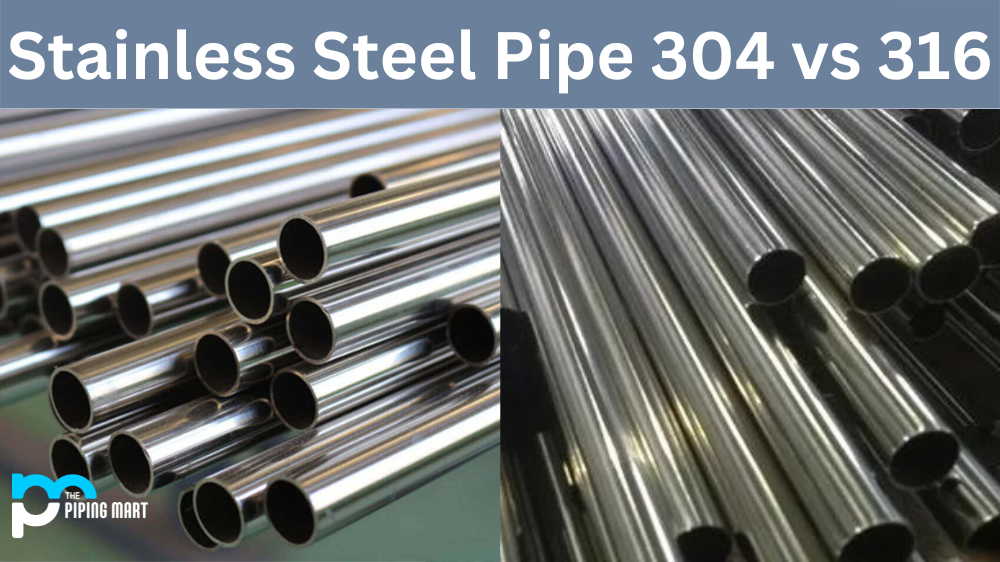When it comes to stainless steel pipe, there are a variety of options available. The two most common types are 304 and 316. While both types offer durability, strength, and corrosion resistance, there are some key differences that you should be aware of before making a purchase. Let’s take a closer look at stainless steel pipe 304 vs 316.
Types of Stainless Steel Pipes
304 stainless steel pipes are one of the most commonly used types due to their affordability and wide range of uses. It resists rust well in dry climates and humid environments and is often used for kitchen equipment, industrial piping and heat exchangers. On the other hand, 316 stainless steel is more resistant to corrosion than 304 because it contains molybdenum—a chemical element that increases its resistance to chloride-ion corrosion. This makes it an ideal choice for applications near salt water or where exposure to chemicals is likely.
304 Stainless Steel Pipe
304 stainless steel pipe is made from a chromium-nickel alloy and is non-magnetic. It has good corrosion resistance and is heat resistant up to 1500 degrees Fahrenheit. 304 stainless steel pipe is used in various applications, including food processing, medical devices, and construction.
316 Stainless Steel Pipe
316 stainless steel pipe is made from a chromium-nickel alloy and is non-magnetic. It has good corrosion resistance and is heat resistant up to 1500 degrees Fahrenheit. 316 stainless steel pipe is used in various applications, including food processing, medical devices, and construction.
Difference Between 304 and 316 Stainless Steel Pipe
The main difference between 304 and 316 stainless steel pipe is the addition of molybdenum to the alloy. Molybdenum is a chemical element that helps to resist corrosion. Additionally, 316 stainless steel pipe has higher levels of chromium and nickel than 304 stainless steel pipe, which makes it more resistant to corrosion.
Strength
Both 304 and 316 stainless steel pipes offer excellent strength and durability–but depending on your application requirements, one may be better suited. For example, while 304 is best suited for outdoor use in coastal areas or areas with high salt content (like swimming pools), 316 is preferable for applications with increased chlorine levels. It’s also worth noting that 304 has a higher tensile strength than 316—which means it can withstand higher pressure levels without breaking or crumbling under stress.
Advantages of 304 Stainless Steel Pipe
One of the main advantages of 304 stainless steel pipe is that it is very versatile. It can be used in various applications, including food processing, medical devices, and construction. Additionally, 304 stainless steel pipe is relatively inexpensive compared to other stainless steel pipes.
Advantages of 316 Stainless Steel Pipe
One of 316 stainless steel pipe’s main advantages is its increased corrosion resistance. Additionally, 316 stainless steel pipe has higher levels of chromium and nickel than 304 stainless steel pipe, which makes it more resistant to corrosion. Additionally, 316 stainless steel pipe is more expensive than 304 stainless steel pipe but may be worth the extra cost for some applications.
Disadvantages of Stainless Steel Pipe
One disadvantage of using stainless steel pipes is that they can be susceptible to scratches or dents. Additionally, they can develop a dull finish over time if not properly maintained.
Conclusion:
Stainless steel pipe is an incredibly versatile material with many practical uses across various industries. Whether you need something strong enough to withstand sea air or chlorine-infused water, there’s an option that’s right for you – 304 or 316 stainless steel pipe! It’s important to weigh all the factors when deciding which type of stainless steel pipe is right for your application – from cost to strength to corrosion resistance – so make sure you consider all your options before making a purchase!

Meet Bhavesh, a seasoned blogger with a wealth of knowledge and experience. From metal products manufacturing to retail, Bhavesh has a diverse background in various industries and is dedicated to sharing his insights and expertise with readers.




